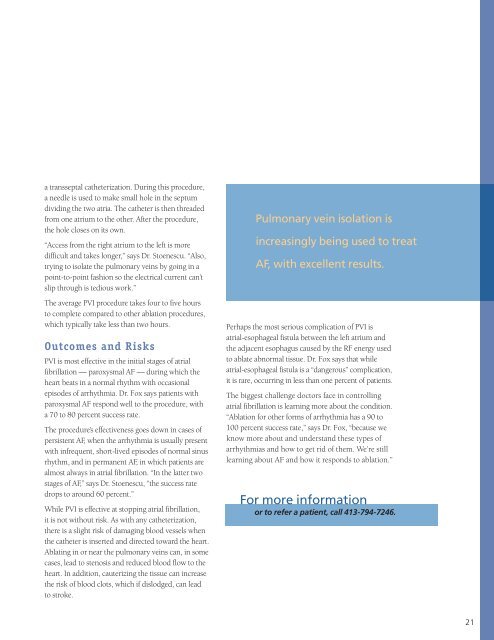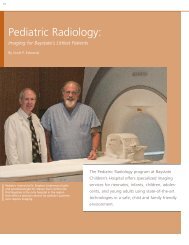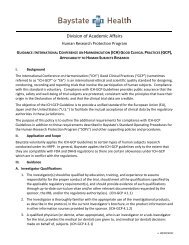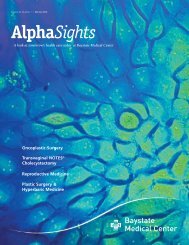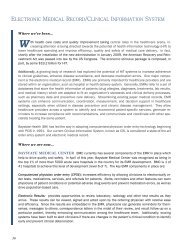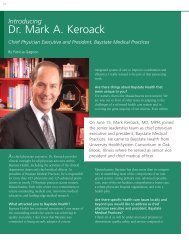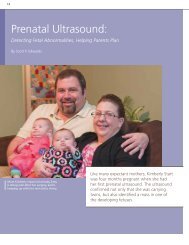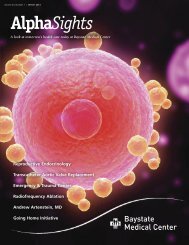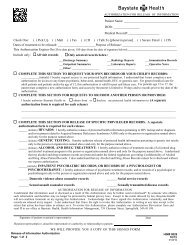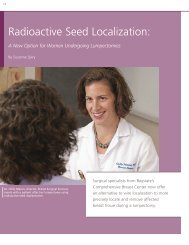Read it in pdf format - Baystate Health
Read it in pdf format - Baystate Health
Read it in pdf format - Baystate Health
You also want an ePaper? Increase the reach of your titles
YUMPU automatically turns print PDFs into web optimized ePapers that Google loves.
a transseptal catheterization. Dur<strong>in</strong>g this procedure,<br />
a needle is used to make small hole <strong>in</strong> the septum<br />
divid<strong>in</strong>g the two atria. The catheter is then threaded<br />
from one atrium to the other. After the procedure,<br />
the hole closes on <strong>it</strong>s own.<br />
“Access from the right atrium to the left is more<br />
difficult and takes longer,” says Dr. Stoenescu. “Also,<br />
try<strong>in</strong>g to isolate the pulmonary ve<strong>in</strong>s by go<strong>in</strong>g <strong>in</strong> a<br />
po<strong>in</strong>t-to-po<strong>in</strong>t fashion so the electrical current can’t<br />
slip through is tedious work.”<br />
The average PVI procedure takes four to five hours<br />
to complete compared to other ablation procedures,<br />
which typically take less than two hours.<br />
Outcomes and Risks<br />
PVI is most effective <strong>in</strong> the <strong>in</strong><strong>it</strong>ial stages of atrial<br />
fibrillation — paroxysmal AF — dur<strong>in</strong>g which the<br />
heart beats <strong>in</strong> a normal rhythm w<strong>it</strong>h occasional<br />
episodes of arrhythmia. Dr. Fox says patients w<strong>it</strong>h<br />
paroxysmal AF respond well to the procedure, w<strong>it</strong>h<br />
a 70 to 80 percent success rate.<br />
The procedure’s effectiveness goes down <strong>in</strong> cases of<br />
persistent AF, when the arrhythmia is usually present<br />
w<strong>it</strong>h <strong>in</strong>frequent, short-lived episodes of normal s<strong>in</strong>us<br />
rhythm, and <strong>in</strong> permanent AF, <strong>in</strong> which patients are<br />
almost always <strong>in</strong> atrial fibrillation. “In the latter two<br />
stages of AF,” says Dr. Stoenescu, “the success rate<br />
drops to around 60 percent.”<br />
While PVI is effective at stopp<strong>in</strong>g atrial fibrillation,<br />
<strong>it</strong> is not w<strong>it</strong>hout risk. As w<strong>it</strong>h any catheterization,<br />
there is a slight risk of damag<strong>in</strong>g blood vessels when<br />
the catheter is <strong>in</strong>serted and directed toward the heart.<br />
Ablat<strong>in</strong>g <strong>in</strong> or near the pulmonary ve<strong>in</strong>s can, <strong>in</strong> some<br />
cases, lead to stenosis and reduced blood flow to the<br />
heart. In add<strong>it</strong>ion, cauteriz<strong>in</strong>g the tissue can <strong>in</strong>crease<br />
the risk of blood clots, which if dislodged, can lead<br />
to stroke.<br />
Pulmonary ve<strong>in</strong> isolation is<br />
<strong>in</strong>creas<strong>in</strong>gly be<strong>in</strong>g used to treat<br />
AF, w<strong>it</strong>h excellent results.<br />
Perhaps the most serious complication of PVI is<br />
atrial-esophageal fistula between the left atrium and<br />
the adjacent esophagus caused by the RF energy used<br />
to ablate abnormal tissue. Dr. Fox says that while<br />
atrial-esophageal fistula is a “dangerous” complication,<br />
<strong>it</strong> is rare, occurr<strong>in</strong>g <strong>in</strong> less than one percent of patients.<br />
The biggest challenge doctors face <strong>in</strong> controll<strong>in</strong>g<br />
atrial fibrillation is learn<strong>in</strong>g more about the cond<strong>it</strong>ion.<br />
“Ablation for other forms of arrhythmia has a 90 to<br />
100 percent success rate,” says Dr. Fox, “because we<br />
know more about and understand these types of<br />
arrhythmias and how to get rid of them. We’re still<br />
learn<strong>in</strong>g about AF and how <strong>it</strong> responds to ablation.”<br />
For more <strong>in</strong><strong>format</strong>ion<br />
or to refer a patient, call 413-794-7246.<br />
21


